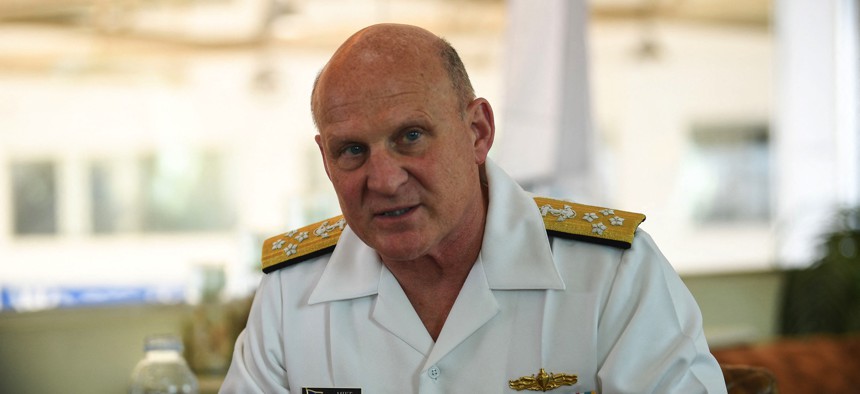
Adm. Michael Gilday, chief of naval operations, speaks in Manila, Philippines, on February 22, 2023. Photo by TED ALJIBE/AFP via Getty Images
The Navy Wants Drones to Counter China’s Gray-Zone Moves
CNO says the upcoming 4th Fleet experiments will inform an eventual move into Indo-Pacific operations.
NATIONAL HARBOR, Maryland—Even as the U.S. Navy expands its drone experiments, its top leaders say the fleet has much to learn before deploying unmanned systems to defend Taiwan from possible attack in the next few years. But they said that lessons from South America’s seas will help the Navy to refine and build intelligence-gathering and -sensing missions that will be highly relevant to countering China.
“The technologies and platforms we are bringing to the region will address several significant challenges,” Navy Secretary Carlos Del Toro said during a Tuesday speech at the Sea-Air-Space conference outside Washington, D.C. “These include narcotics and human trafficking, as well as economic and ecological harm caused by illegal, unreported and unregulated fishing, which the People's Republic of China with their distant water fishing fleet participates, in both the Pacific Coast and the Atlantic Coast.”
While alarm is rising that Beijing may invade Taiwan this decade, some China watchers have pointed out that the country’s Navy and Coast Guard have for years been harassing fishermen from smaller countries, such as the Philippines. The Chinese military is taking more actions that—while beneath the threshold of armed conflict—still qualify as aggressive. in the eyes of the U.S. Defense Department.
That building harassment is evidence of a “cumulative strategy,” James Holmes, a Naval War College strategy professor, said at the conference on Monday: a growing series of disconnected actions that have a larger effect taken together, like an insurgency, as opposed to a single large, dramatic assault.
“Imagine the situation in the South China Sea through the eyes of the Philippines or Vietnamese fisherman, coast guardsman, or sailor? It looks grim,” Holmes said. “He sees the Chinese fishing fleet, the militia embedded in it, and the world's largest coast guard, all backed up by the PLA Navy and shore-based aircraft and missiles. This force utterly outmatches his coast guard and his navy.”
Brig. Gen. Simon Doran, USMC director of strategy and plans, policies and operations, said, “I think the PRC-sponsored maritime militias, you know, they operate in a way that allows them to try and push their their maritime claims, potentially, in an effort to gain additional scarce resources and certainly an effort to exhaust some of their neighbors.”
Said Gilday: “There's no better way to compete with the PRC and gray-zone activity than to expose it.” Moving more unmanned platforms into the waters around South America “gives us the ability to keep a moving, unblinking eye on that activity as well,” he said.
Still, Gilday reiterated his reluctance to run such experiments and deploy large numbers of unmanned systems to the Indo-Pacific region, at least for now.
Asked why, the CNO said, “I still think we have a lot to learn with respect to a relatively benign environment…We want to scale this…The Southern Command [area of responsibility] seemed like a perfect environment for us to do this and to get after…those real-world missions.”
The admiral said he expects the Navy to put a large unmanned vessel under contract within four years. The fleet will likely deploy large “minimally-manned” unmanned surface vessels, like the Sea Hunter, before operating them without any humans onboard.
He also suggested large unmanned ships might someday operate with an “offensive capability.”
“That will be a line-of-sight platform that stays with a carrier strike group or a surface surface action group. We'll start off lightly, minimally manned, and evolve to unmanned over time as we perfect or mature, autonomous capabilities. And then, in the future, we think that a large unmanned platform could have defensive capability as well,” he said.
“We have been doing testing as you know, during major exercises, including RIMPAC and we expect to do more with allies and partners as those as those as that dialogue continues. I think today's announcement might be a harbinger for, you know, for or a call to action, if you will, for others to join us,” he said.
Gilday said that the Navy has put more 50,000 nautical miles on large unmanned surface vessels during tests. “We have a high degree of confidence in the AI's ability to follow rules and to avoid traffic, to stay within the channel when required. We've made transits from the Gulf Coast of the United States repeatedly through the Panama Canal and up around to...California. That said, it's a whole ’nother level that you allude to, to give an unmanned vessel a mission and then have that vessel report back ‘mission complete’.”




